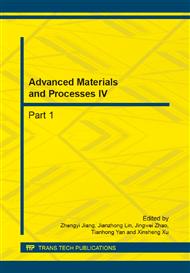p.545
p.550
p.554
p.558
p.562
p.569
p.574
p.579
p.583
Electrosprayed PVP/Shellac Composite Medicated Microparticles for Providing Biphasic Drug Release Profile
Abstract:
The present study reports that a sustained release profile could be transferred into a biphasic drug release profile when a hydrophilic polymer was encapsulated into the medicated microparticles. The multiple component composite microparticles were fabricated using a single fluid electrospraying process to treat a co-dissolving solution consisting of a polymer matrix (shellac), an active ingredient (FA), and an additional hydrophilic polymer (poly vinyl pyrrolidone, PVP). FESEM results showed that the microparticles M1 consisting of shellac and FA had an average diameter of 1.27 ± 0.38 μm, whereas the microparticles M2 consisting of shellac, FA and PVP had an average diameter of 1.51 ± 0.34 μm. Both the two types of microparticles were essentially amorphous composites due to the favourable secondary interactions between the components, as demonstrated by ATR-FTIR tests. In vitro dissolution tests demonstrated that the addition of PVP in the microparticles M2 made them give a typical biphasic drug release profile, whereas the double-component microparticles provided a sustained release profile. This study shows a simple way for developing advanced drug delivery systems through tailoring the components of polymer excipients using electrospraying.
Info:
Periodical:
Pages:
562-566
Citation:
Online since:
September 2014
Authors:
Keywords:
Price:
Сopyright:
© 2014 Trans Tech Publications Ltd. All Rights Reserved
Share:
Citation:


